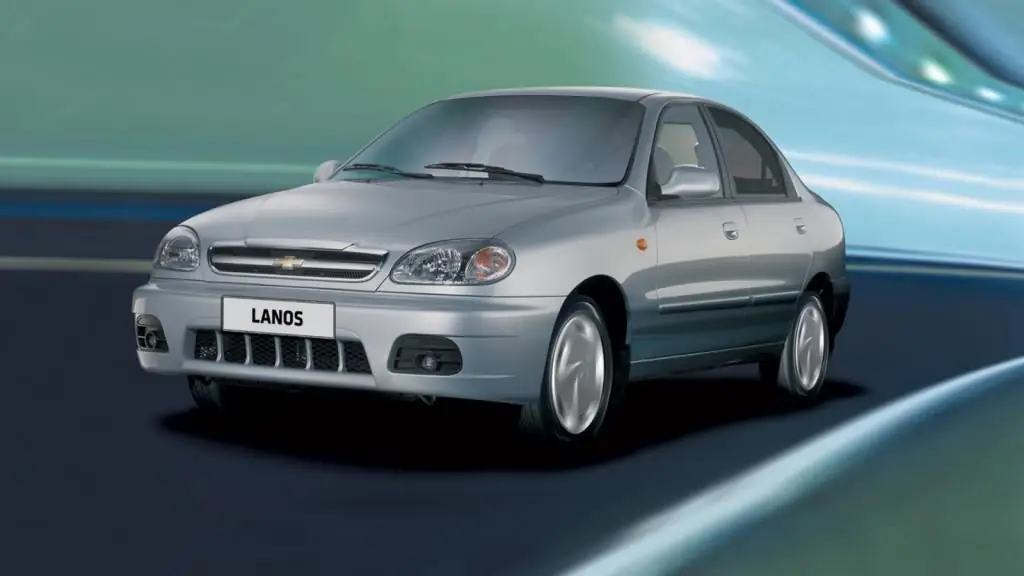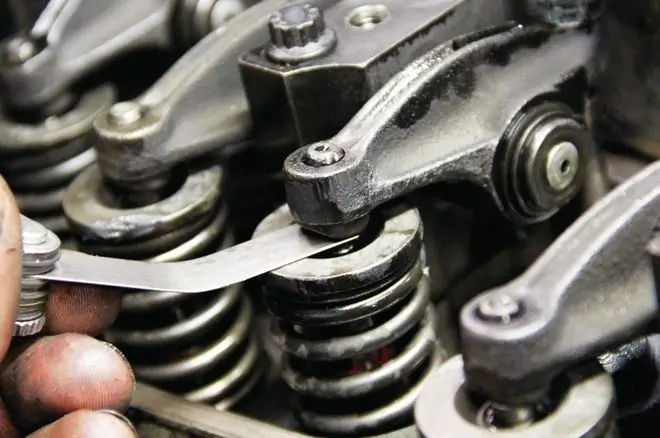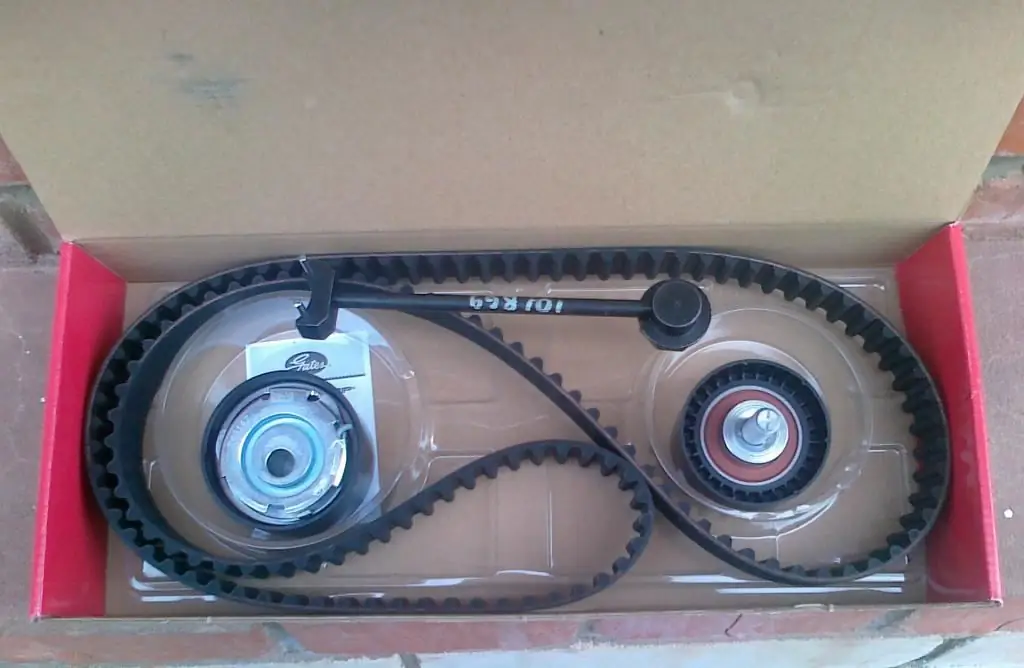2025 Author: Erin Ralphs | [email protected]. Last modified: 2025-01-22 21:14:09
One of the most popular cars today is the Lada Priora. Replacing the timing on this model, as it turned out, is a fairly common phenomenon. In general, Priora is a good car. It has a relatively modern design and is equipped with a reliable VAZ-21126 engine - a 16-valve engine with a displacement of 1.6 liters.
The quality of the timing belt is a significant drawback of Priora. If the timing belt breaks, the valves are damaged - they bend. To avoid an accident, you need to change the drive belt in a timely manner. You can do it yourself, as the procedure is simple. But you will need to understand certain nuances of replacing the timing belt on the Priore with a 16-valve engine.
What is a timing belt?
The timing belt is made from rubber. It has teeth on the inside. Toto make such a belt, it is necessary to use only heavy-duty rubber grades. The belt connects the gears of the camshaft and crankshaft. This allows you to synchronize the operation of the mechanisms as clearly as possible. Thanks to the gas distribution mechanism, the fuel mixture is supplied to the combustion chambers in a timely manner, and the exhaust gases exit from it.

The teeth are needed to ensure that the connection with the gears is as reliable as possible, this almost completely eliminates slippage. Belts with 137 teeth are installed on Lada Priora cars. If a break occurs, the car will not even be able to start, let alone drive further. In order to exclude the possibility of a break, it is necessary to carry out repairs at the frequency recommended by the manufacturer.
Replacement frequency
Don't tempt fate: change the timing belt every 60,000 km. It should be noted that wide timing belts are installed on some Priora engines, and they are characterized by a high resource, as they will last 200,000 km.
If you notice that there is damage or even slight signs of wear on the surface of the timing belt, but the mileage has not yet reached the prescribed value, you should still replace it. This is extremely important, as a break will cause the valves to fail, and then the entire cylinder head will have to be repaired.
What else does the belt do?
ExceptSince the timing belt transmits movement from the crankshaft to the camshaft, it also drives the fluid pump. The value of the belt is difficult to overestimate. It is very important in the design of the motor, since without a belt, the operation of the engine is simply impossible.

As we mentioned above, the timing belt is replaced every 60,000 km. But it is recommended to do this a little earlier, since the state of the timing cannot always be judged by mileage. If you live in a city and often drive through traffic jams, then it is unreasonable to count mileage. The engine is idling most of the time and the car is not moving. In this case, it makes much more sense to use the engine hour meter. Therefore, it is best to reduce the interval between replacements to about 40,000 km. This is the maximum drive belt life.
Symptoms of broken timing belt
There are several factors that indicate that it is necessary to change the timing belt:
- extraneous noises appear during engine operation at low speeds and in idle mode;
- exhaust color changes;
- difficulty starting the engine;
- vibration appears.
If antifreeze, oil or dirt gets on the timing surface, wear will increase several times.
Action of liquids and dirt
Antifreeze and antifreeze are especially dangerous for rubber. In the event that a coolant leak occurs due to a gasket failureliquid pump or failure of the latter, then the resource of the belt decreases. If you detect a coolant leak, try to quickly identify the causes in order to eliminate them as soon as possible.

If the integrity of the gasket or pump is broken, then when replacing these elements, it is necessary to install a new belt. In the event that there are problems with the strength of the belt, when the engine is running at high speeds, the pistons may break and the connecting rods may be deformed.
Preparatory work
Please note that if you have air conditioning, you will have to perform a few more manipulations to facilitate access to the timing mechanisms. Replacing with "Prior" in this case is a little more difficult, as preparation is required:
- Loosen the alternator tensioner pulley. In the event that a hum is heard from the side of the roller during operation, it must be replaced.
- Remove the alternator drive belt. It is also better to immediately replace it with a new one.
Now you open access to two covers that cover the entire gas distribution mechanism. Using a bit in the form of an asterisk or a hex, you need to unscrew the five bolts securing the top cover. After that, unscrew the two bolts that secure the lower cover of the gas distribution mechanism compartment.
Procedure of work

Next, you need to perform a series of actions to replace the timing belt on the "Prior":
- Turn off the crankshaft sensorshaft. To do this, disconnect the corresponding chip, which is located near the upper compartment of the gas distribution mechanism.
- Place a jack on the passenger side to lift the wheel. This will allow you to align the marks on the camshaft pulleys.
- You can combine the marks by rotating the crankshaft using the key to "17". But it's much easier to do this by spinning the wheel in fifth gear.
- In the event that you are not going to change the pump, you will not need to unscrew the fastening of the camshaft pulleys.
- As soon as you set the marks, you need to set the gearshift lever to a position that corresponds to neutral. This will keep the marks in the correct position.
- Check the marks on the flywheel.
If you plan to replace the pump, you will need to loosen the fasteners of the camshaft pulleys. The bolts just need to be loosened - there is no need to remove them completely.
Final dismantling
When replacing the timing on the "Prior" with your own hands, you need to follow a certain sequence.

Final works:
- To access the crankshaft pulley, you must completely remove the wheel or turn it to the right until it stops.
- Unscrew the bolts securing the mudguard - in this case, you will have full access to the crankshaft pulley.
- You can unscrew the crankshaft pulley bolt if you turn on fifth gear and depress the brake pedal. Using a wheelbrace or ratchet with a "17" socket, you mustunscrew the bolt. It is not recommended to do this with ring or open-end wrenches, as you can "lick off" the edges.
- Using the key on "15" it is necessary to unscrew the bolts that secure the tension and support rollers.
- Remove the timing belt.
Removing and replacing the pump
If you need to install a new pump when replacing the timing on the Priore with a 16-valve engine, you will need to remove the casing located inside. To do this, you need to dismantle the camshaft pulleys, unscrew the three bolts that secure the generator holder. In addition, to remove the casing, you will need to unscrew six more bolts. Two of them are located directly behind the camshaft pulleys.
After that, remove the inner casing and get access to the pump mount. To remove it, you need to unscrew the three bolts. You can unscrew them only with the help of a hexagon on "5". Be sure to completely drain the cooling system.

Install all elements in reverse order. Before installing the pump, it is necessary to fix the gasket on it with a high temperature sealant. Do not apply great force when tightening the pump bolts, otherwise you can strip the threads. The tensioner pulley should not be fully tightened when reassembling, as adjustments will still be made after the belt is installed.
Recommended:
Replacing the timing belt on Lanos with your own hands: features of the work

In the article you will learn how the timing belt is replaced on Lanos. The state of this element must be monitored as closely as possible, since literally everything depends on it - both your financial well-being and the operation of the engine. The fact is that a broken belt can lead to the breakdown of several valves, and the cost of repairs is quite high. Some motorists naively believe that Lanos is a cheap car with nothing to break
Adjustment of engine valves 4216 "Gazelle": procedure, work technique, necessary tools and expert advice

Car enthusiasts can do without the services of specialized car repair shops if it is necessary to adjust the valves of the 4216 Gazelle engine. Consider how this is done with your own hands in a garage environment
Replacing the crankshaft pulley: instructions, tools, workflow

Internal combustion engines are equipped with additional equipment - these are generators, air conditioning compressors, a pump for the cooling system. All these devices receive torque from the crankshaft through a pulley. The latter eventually becomes unusable due to natural wear and tear. As a result, the car needs to replace the crankshaft pulley. Let's see how to perform this operation
Professional car polishing: tools and technology

Professional car body polishing: features, technology. Do-it-yourself professional car body polishing: recommendations, tools
Carbon pasting: necessary materials and tools, pasting technology

Pasting car parts with carbon fiber is becoming increasingly popular both in the world and in Russia. And this is not surprising, since the film protects the surface from chips and cracks, and also gives the car a great appearance

